The Deep Sea Aliens
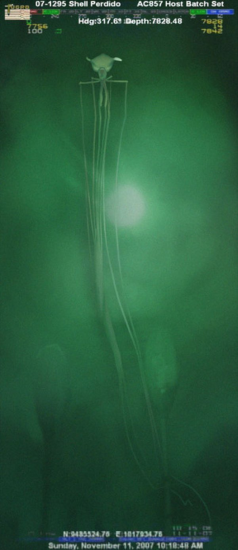
Magnapinna big fin squid
Shell Oil company caputured the elusive big fin squid on video using its remotely operated submersible at a depth of 2.3 KM (1.5 miles). Very little is known about these squids, scientists belive that the bigfin squid drags its tentacles along the seafloor and grabbing edible organisms off the floor. Estimates based on video evidence put the total length of the largest specimens at 8 metres (26 ft) or more.
https://en.wikipedia.org/wiki/Bigfin_squid
Shell Oil company caputured the elusive big fin squid on video using its remotely operated submersible at a depth of 2.3 KM (1.5 miles). Very little is known about these squids, scientists belive that the bigfin squid drags its tentacles along the seafloor and grabbing edible organisms off the floor. Estimates based on video evidence put the total length of the largest specimens at 8 metres (26 ft) or more.
https://en.wikipedia.org/wiki/Bigfin_squid
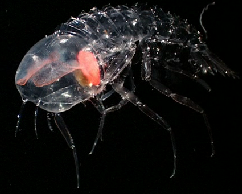
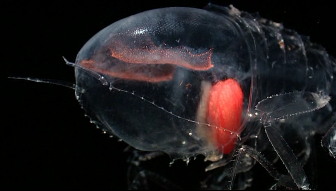
Giant Amphipod
They have been found at depths of 500 m. It has a completely transparent body, with the exception of its stomach and its compound eyes. The eyes occupy the entire top of its head, and the retinas can be seen as a thin layer of red in the otherwise clear head.
They have been found at depths of 500 m. It has a completely transparent body, with the exception of its stomach and its compound eyes. The eyes occupy the entire top of its head, and the retinas can be seen as a thin layer of red in the otherwise clear head.
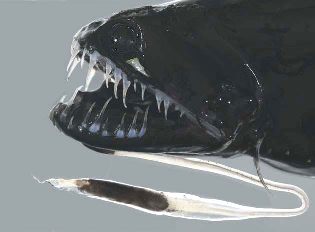
Dragonfish
The deep sea dragonfish is a ferocious predator in spite of its small size. The dragonfish has a long barbel attached to its chin. This barbel is tipped with a light-producing organ known as a photophore. These fishes are sexually dimorphic (the males and females look different). Dragonfishes live in deep ocean waters at depths of up to 1500 m (5000 feet).
http://www.allthesea.com/Deep-Sea-Fish-Dragonfish.html
The deep sea dragonfish is a ferocious predator in spite of its small size. The dragonfish has a long barbel attached to its chin. This barbel is tipped with a light-producing organ known as a photophore. These fishes are sexually dimorphic (the males and females look different). Dragonfishes live in deep ocean waters at depths of up to 1500 m (5000 feet).
http://www.allthesea.com/Deep-Sea-Fish-Dragonfish.html
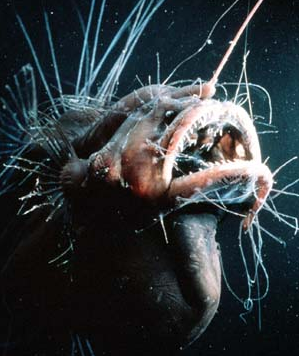
Hairy Angler
The hairy angler is the size of a beach ball and its body is covered in long antennae designed to pick out the movements of any prey foolish enough to venture close to its terrifying teeth.
https://en.wikipedia.org/wiki/Anglerfish
The hairy angler is the size of a beach ball and its body is covered in long antennae designed to pick out the movements of any prey foolish enough to venture close to its terrifying teeth.
https://en.wikipedia.org/wiki/Anglerfish
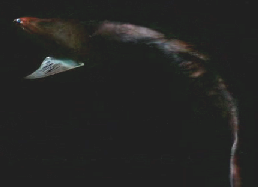
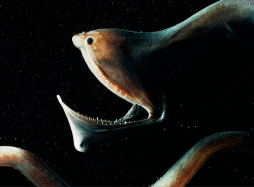
Gulper eel
A gulper eel engulfs its prey in its huge, pelicanlike mouth. It can unhinge its enormous jaws and stretch its stomach to consume a fish as big as itself. They are generally black in color, and can grow to lengths of 2 m (6.5 feet). They have been found at depths of 1,800 m (6,000 feet). Their tails are tipped by a luminous bulb-shaped organ.
https://www.mbayaq.org/efc/living_species/default.asp?inhab=186
A gulper eel engulfs its prey in its huge, pelicanlike mouth. It can unhinge its enormous jaws and stretch its stomach to consume a fish as big as itself. They are generally black in color, and can grow to lengths of 2 m (6.5 feet). They have been found at depths of 1,800 m (6,000 feet). Their tails are tipped by a luminous bulb-shaped organ.
https://www.mbayaq.org/efc/living_species/default.asp?inhab=186
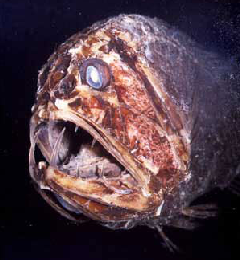
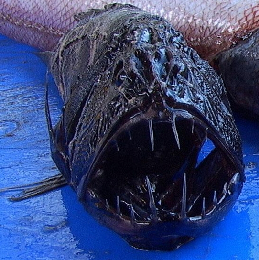
Fangtooth
While understandably named for their disproportionately large, fang-like teeth and unapproachable visage, fangtooths are actually quite small and harmless to humans. They are more commonly found between 200 - 2,000 metres (660 - 6,560 feet). Fangtooths are known to be robust when compared to many other deep-sea fish; they have been kept alive for months in aquariums despite conditions which are significantly different from their natural habitat.
https://en.wikipedia.org/wiki/Fangtooth
While understandably named for their disproportionately large, fang-like teeth and unapproachable visage, fangtooths are actually quite small and harmless to humans. They are more commonly found between 200 - 2,000 metres (660 - 6,560 feet). Fangtooths are known to be robust when compared to many other deep-sea fish; they have been kept alive for months in aquariums despite conditions which are significantly different from their natural habitat.
https://en.wikipedia.org/wiki/Fangtooth
Page 1 2 3 4
